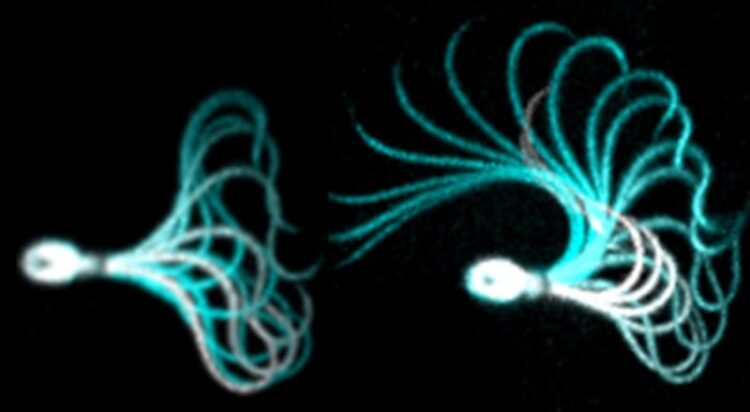Defective ion channel in sperm flagellum

Beating pattern of a human sperm cell before (left) und after (right) activation of CatSper. The more powerful beat is required to fertilize the egg
Credit: University of Münster / Strünker group
… renders men infertile and frustrates medically assisted reproduction.
In half of the couples that are unable to conceive a child, the infertility is due to the man. A new study identifies the defective function of ‘CatSper’, an ion channel controlling calcium levels in sperm, as a common cause of seemingly unexplained male infertility. CatSper-deficient human sperm fail to fertilize the egg, because they cannot penetrate its protective vestments. Thus far, this sperm channelopathy has remained undetectable. Scientists from Münster, Germany, have unravelled CatSper´s role in infertility using a novel laboratory test that identifies affected men. Based on the results of the study diagnostics and care of infertile couples can be improved.
One in six couples fail to conceive a child. The underlying cause often remains unresolved. In fact, in about one third of infertile couples, the man´s semen analysis yields no abnormalities in the number, motility, or morphology of the sperm. This poses a problem: the lack of a clear diagnosis prevents an evidence-based selection of a therapy option. As a result, affected couples often experience unsuccessful treatments.
How do men fail to conceive a child despite normal semen parameters? An interdisciplinary team of scientists from the University of Münster in Germany, set out to answer this question. ‘For quite a while, we have considered CatSper a prime suspect’ says Prof. Timo Strünker from the Centre of Reproductive Medicine and Andrology (CeRA). Some years ago, Strünker and colleagues revealed that sperm use CatSper as a sensor to detect messenger molecules released by the egg. These molecules activate CatSper, which leads to an influx of calcium into the flagellum, changing its beating pattern.
To scrutinize whether this is essential for fertilization, the researchers developed a simple laboratory test that enabled them to determine the activity of CatSper in sperm from almost 2300 men. This revealed that about one in a hundred infertile men with unremarkable semen parameters indeed features a loss of CatSper function. ‘The most common cause is genetic variants in genes encoding one of CatSper’s components’, adds the Reproductive Geneticist Prof. Frank Tüttelmann, Münster.
Sperm require the changes in flagellar beating mediated by CatSper to break through the egg´s protective coat. Another important finding of the study: CatSper-related male infertility also involves failure of medically assisted reproduction via intrauterine insemination, involving the application of sperm via a catheter into the uterus right before ovulation, or classical in-vitro fertilization (fertilization in the petri dish). This is not surprising, considering that these treatments still require the sperm to break through the egg coat. Affected men/couples could only conceive a child via the ICSI method, which involves the manual injection of a sperm cell into the egg.
‘Thanks to this comprehensive research endeavour, we can now identify and diagnose this channelopathy, enabling evidence-based treatment of affected couples’, summarizes Prof. Sabine Kliesch, Head of the Department of Clinical and Surgical Andrology at the CeRA. ‘Thereby, we minimize the medical risk for the couples and maximize the chances of success’.
The function of sperm is not only controlled by CatSper but also various other proteins. These are also in the focus of the Clinical Research Unit (CRU326) ‘Male Germ Cells‘, which, funded by the German Research Council, provided the collaborative framework for the current study. The overarching aim of the researchers in Münster is to systematically elucidate the role of these proteins in (in)fertility, improving diagnostics and care of affected couples.
Wissenschaftliche Ansprechpartner:
Prof. Timo Strünker
Molecular Reproductive Physiology
Center of Reproductive Medicine and Andrology
University of Münster
Tel. +49-173-2517005
timo.struenker@ukmuenster.de
Originalpublikation:
https://doi.org/10.1172/JCI173564
Weitere Informationen:
https://www.medizin.uni-muenster.de/en/cera.html Center of Reproductive Medicine and Andrology
https://www.medizin.uni-muenster.de/male-germ-cells/home/ Clinical Research Unit (CRU326) ‘Male Germ Cells‘
Media Contact
All latest news from the category: Health and Medicine
This subject area encompasses research and studies in the field of human medicine.
Among the wide-ranging list of topics covered here are anesthesiology, anatomy, surgery, human genetics, hygiene and environmental medicine, internal medicine, neurology, pharmacology, physiology, urology and dental medicine.
Newest articles

Innovative 3D printed scaffolds offer new hope for bone healing
Researchers at the Institute for Bioengineering of Catalonia have developed novel 3D printed PLA-CaP scaffolds that promote blood vessel formation, ensuring better healing and regeneration of bone tissue. Bone is…

The surprising role of gut infection in Alzheimer’s disease
ASU- and Banner Alzheimer’s Institute-led study implicates link between a common virus and the disease, which travels from the gut to the brain and may be a target for antiviral…

Molecular gardening: New enzymes discovered for protein modification pruning
How deubiquitinases USP53 and USP54 cleave long polyubiquitin chains and how the former is linked to liver disease in children. Deubiquitinases (DUBs) are enzymes used by cells to trim protein…



